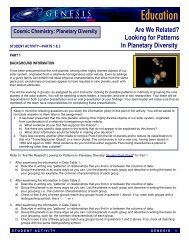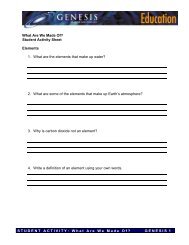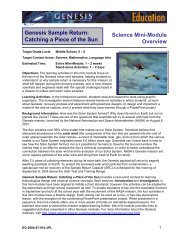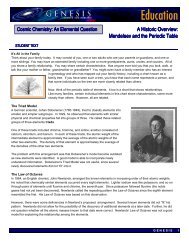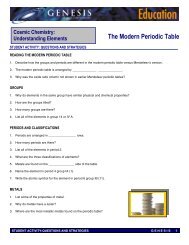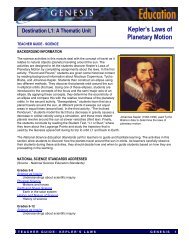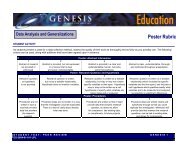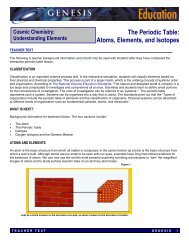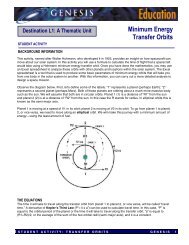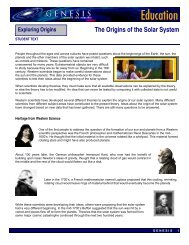Genesis Launch Vehicle: The Delta Rocket - Genesis - NASA
Genesis Launch Vehicle: The Delta Rocket - Genesis - NASA
Genesis Launch Vehicle: The Delta Rocket - Genesis - NASA
Create successful ePaper yourself
Turn your PDF publications into a flip-book with our unique Google optimized e-Paper software.
<strong>The</strong> image at left shows the three stages of the <strong>Delta</strong> II rocket, as it appears<br />
when mated with the <strong>Genesis</strong> spacecraft. <strong>The</strong> <strong>Genesis</strong> spacecraft sits on top of<br />
the third stage, which includes 9.5-foot fairings. <strong>The</strong> solar panels are folded<br />
inward during the time in which it is in the rocket. Note that the fairings protect<br />
the <strong>Genesis</strong> spacecraft as well as the second and third stage of the rocket.<br />
<strong>The</strong> <strong>Genesis</strong> spacecraft is launched from Cape Canaveral Air Force Station on<br />
launch pad 17 A. This launch pad is where all of the <strong>Delta</strong> rockets are launched.<br />
A lot of history has happened at this launch pad, according to author L.B.<br />
Taylor; visitors can see impressions of rockets on the north side of the pad.<br />
Near the launch pad there is an image of the red bellied woodpecker with a<br />
cross beside it, symbolizing a perfect launch.<br />
History of the <strong>Delta</strong> <strong>Rocket</strong><br />
<strong>The</strong> <strong>Delta</strong> rocket was derived from the Thor rockets used by <strong>NASA</strong> in the late 1950’s. <strong>The</strong> fourth modification to the Thor<br />
rocket caused <strong>NASA</strong> Director of Spacecraft and Flight Missions Milton Rosen to refer to the rocket with the Greek letter<br />
<strong>Delta</strong>. <strong>The</strong> name was officially adopted in January of 1959. In April of that same year <strong>NASA</strong> signed its first launch vehicle<br />
contract with Douglas Aircraft Company for 12 <strong>Delta</strong> <strong>Rocket</strong>s.<br />
<strong>The</strong> first <strong>Delta</strong> launch carrying the Echo Passive Communications Satellite<br />
failed on May 13, 1960 because the third stage did not ignite. However, the<br />
next 22 launches were successful. <strong>The</strong> first of these was the <strong>Delta</strong> 2, which<br />
carried the Echo I satellite into orbit on August 12, 1960. It reflected a radio<br />
message from President Eisenhower across the Nation, demonstrating the<br />
feasibility of global radio communications via satellites. <strong>The</strong> image at left<br />
shows technicians as they examine the Echo satellite payload. <strong>The</strong> 26-inch<br />
diameter magnesium sphere contains a balloon, which was launched into<br />
orbit, where it was released and inflated. <strong>The</strong> Echo I had a diameter of 30.48<br />
meters and was the largest satellite launched at the time. Because it was so<br />
bright in the night sky, it was probably seen by more people than any other<br />
human made object. At the time, the newspapers printed the times that this<br />
satellite could be seen. In 1961, Belgian physicist, Barcel Nicolet studied the<br />
<strong>The</strong> Echo I satellite was launched in<br />
Echo satellite so closely that he could calculate the drag of the thin<br />
1960. atmosphere in which the satellite was traveling. He was then able to<br />
calculate the density of this region known as the heliosphere<br />
Other notable early launches included the <strong>Delta</strong> 8, which carried the first Orbiting<br />
Solar Observatory (OSO) on March 7, 1962. This was the first time the sun was<br />
studied beyond Earth’s atmosphere. <strong>The</strong> observatory, shown at right, helped<br />
scientists study the sun in the ultraviolet, x-ray and gamma regions of the<br />
spectrum.<br />
<strong>The</strong> Ariel 1 was the first<br />
international satellite.<br />
Sun sensors connected to servo-feedback<br />
systems on the upper "sail" portion were<br />
designed to keep the pointed instruments<br />
aimed toward the center of the sun. <strong>The</strong> lower<br />
spinning portion carried instruments and<br />
<strong>The</strong> Orbiting Solar Observatory was the<br />
rotated once every two seconds, allowing first time we could study the sun above<br />
those instruments to scan the solar disk and the atmosphere.<br />
atmosphere. <strong>The</strong> OSO had three protruding<br />
arms that extended after deployment. Among many of the discoveries made from the<br />
observations by the battery of instruments on OSO was that the sun's corona had<br />
openings, now called coronal holes, which were interpreted as huge fast-moving<br />
bubbles rising through the corona.<br />
STUD ENT TE XT: TH E DELTA RO CK ET<br />
G E N ESI S<br />
2



